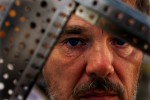Former UCLA professor Chris Burden, the artist behind the iconic “Urban Light” exhibition at the Los Angeles County Museum of Art, died Sunday of malignant melanoma. He was 69.
Since the installation of “Urban Light” in 2008, the 202 restored street lamps have brightened the entrance of LACMA and become one of the most photographed public spaces in Los Angeles.
The artist taught as an art professor at UCLA beginning in 1978, becoming tenured in 1986.
Chris Waterman, the current dean of the UCLA School of the Arts and Architecture, was the dean of six departments, including the art department, when Burden taught at UCLA. He said Burden was among a group of artists who shaped UCLA’s art department towards a preeminent studio-based system.
“The range of his work was astonishing,” Waterman said. “There was a sense of humor that ran through his work.”
Hirsch Perlman, the current chair of the art department at UCLA, said he worked on graduate student thesis committees with Burden. He said Burden was one who began to define the art department as a space for actively practicing artists who also commit to teaching.
Burden created paradoxically humorous pieces, Perlman said, and helped establish the New Genres area at UCLA to focus on interdisciplinary art.
Burden started the New Genres area, added to the UCLA Department of Art, around 1978 and was a perfect example of artists responding to their times, said Jennifer Bolande, the current area head of New Genres. The New Genres area includes performance, installation, video, audio and developing forms of art that are not precisely defined.
“I was just talking to my class yesterday and just saying that without Chris we probably wouldn’t be here in this New Genres classroom,” Bolande said. “He built the area, he carved out the space.”
Known for his use of the body in art, Burden’s early performing works include “Five Day Locker Piece,” for which he confined himself inside a school locker, and “Shoot,” for which he was shot in the arm. Bolande said he challenged the assumptions we hold about reality, testing the duration of what’s possible for a person.
“Chris was pure, brilliant and uncompromising – the quintessential rebel,” said Ann Philbin, current director of the Hammer Museum, in a statement. “He was an L.A. treasure.”
Bolande said Burden is influential because of the breadth and depth of his work that pushed the psychological, physical and political limits of art.
“He was always very plain spoken, something of a curmudgeon, but with a very sort of funny self-deprecating humor,” Perlman said. “It’s a big loss to the art world at large, not just UCLA’s history.”
Alumnus Troy Cherney, who graduated in 1983, was a student in one of Burden’s installation courses. For an indoor installation project, Cherney imagined a corner of an art studio tilted 90 degrees. He said Burden supported turning his vision into a reality, as Cherney decorated the wall with carpet and the floor with wallpaper.
“He was one of best professors I’ve had,” Cherney said. “He created an environment where everybody could experiment and succeed or fail, and it didn’t matter as long as you were trying to learn.”
As a professor, Burden offered perceptive comments to student work and posed questions to force artists to think about their pieces, Cherney said. He said Burden not only valued bringing student ideas to life but also that he was a major force in 21st century art.
Cherney recalled one of Burden’s spontaneous projects at UCLA that involved a giant plywood wheel, or donut. Burden stood inside, secured his feet and grabbed the handles as passersby pushed the wheel – with Burden inside – all the way up Bruin Walk.
Before “Urban Light” was purchased by LACMA, Waterman said he saw the budding project. Burden had been traveling around Los Angeles to salvage 1920s-era street lamps that were going to be discarded, Waterman said, and it took his breath away when Burden turned on the awe-inspiring display.
“Very few people knew that he’d been ill,” Waterman said. “This was really just a tremendous shock because he was one of the major figures in Los Angeles art.”
Burden and his wife Nancy Rubins, who survives him, retired as art professors at UCLA in 2005 over the university’s lack of discipline for a student’s controversial artwork.
“Chris has left his mark not only on the art world but also on Los Angeles,” said LACMA CEO Michael Govan in a statement. “(‘Urban Light’) stands as a testament to the lasting power of Chris Burden’s talent, skill and imagination.”
